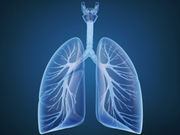High urokinase plasminogen activator receptor serum levels linked to severe, non-atopic disease
FRIDAY, Sept. 23, 2016 (HealthDay News) — Urokinase plasminogen activator receptor (uPAR) is elevated in patients with asthma, with high uPAR levels linked to severe, non-atopic disease, according to a study published online Sept. 14 in Allergy.
Michael A. Portelli, B.Pharm., Ph.D., from the University of Nottingham in the United Kingdom, and colleagues determined the uPAR expression profile in asthma and control subjects using bronchial biopsies and serum. uPAR levels were examined in nine control and 27 asthmatic bronchial biopsies using immunohistochemistry. In U.K. (129 cases, 39 controls) and Dutch (441 cases, 96 controls) cohorts, soluble cleaved (sc) uPAR levels were determined in serum.
The researchers found that in the bronchial tissue of asthma patients, uPAR was elevated in lamina propria, bronchial epithelial, and airway smooth muscle cells, with uPAR levels correlated between cell types. There were no correlations with disease severity or asthma clinical features. In asthma patients, scuPAR levels were elevated 1.5-fold (P = 0.0008) and there was a correlation between high uPAR serum levels and severe, non-atopic disease.
“This study provides novel data that elevated airway and blood uPAR in asthma is particularly related to severe, non-atopic asthma,” the authors write. “The findings warrant further investigation and may provide a therapeutic opportunity for this refractory population.”
Several authors disclosed financial ties to the pharmaceutical industry.
Copyright © 2016 HealthDay. All rights reserved.








